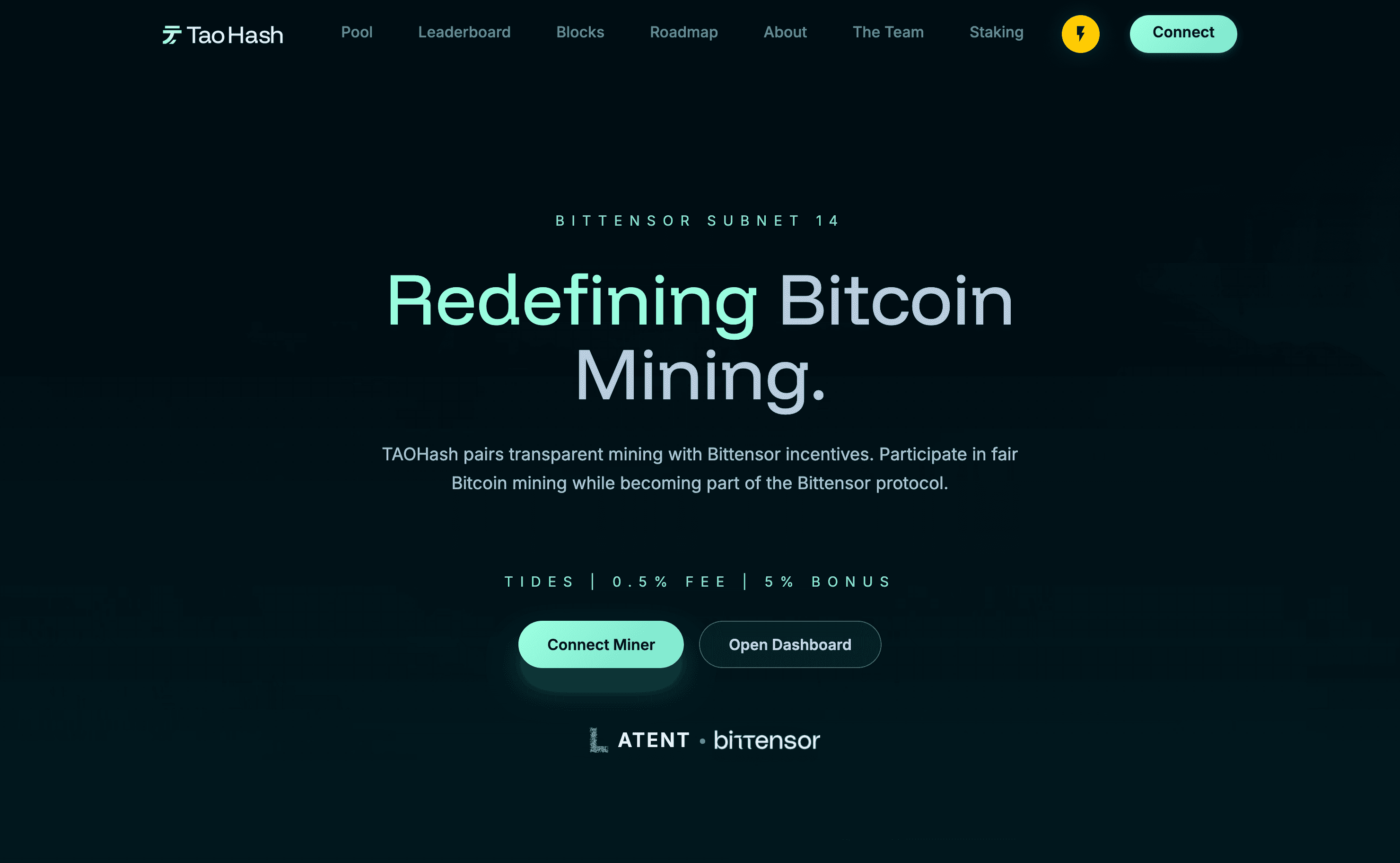TAOHash is a Subnet for decentralizing PoW mining hashrate- rental and financialization. Validators incentivize miners to pool hashrate with them, rewarding them with Alpha based on the value of that hashrate.
Traditional Bitcoin mining pools operate with a fundamental ownership problem. Mining pools generate millions in fee revenue, but pool operators keep all of it. The miners who support the pool get none of the pool's ownership benefits.
This creates a broader issue with how mining pools operate. Mining pools work like "black boxes". Operators control all decisions behind closed doors. They can change fees, alter payouts, or modify operations without warning. Miners do not know how these decisions are made, and cannot tell if they are treated fairly.
This centralized control creates misaligned incentives. Pool operators focus on making profits, and may not provide the best service to miners. Since no one else has ownership stakes, they cannot influence pool policies. Miners also don't benefit from the pool's success beyond their mining rewards.
TAOhash solves this by making the mining pool community-owned rather than corporate-controlled. The difference is that TAOhash's ALPHA holders own the pool. The open ownership structure enables anyone to own a part of it.

The mining pool charges a 2% fee on all mining revenue. This fee is directly claimable by ALPHA holders based on their ownership. Anyone can buy ALPHA tokens to own part of the pool. This includes miners, investors, and community members.
Miners who hold ALPHA tokens get two benefits: mining rewards and pool revenue shares. The more successful the pool becomes, the more valuable their ownership stakes become. Through their ALPHA rewards, miners also become owners of the pool passively.
MINING POOL FEES
Currently, these fees are being accumulated and will be claimable by ALPHA holders through a smart contract when implementation is complete.
Bitcoin mining means solving complex math puzzles to secure the Bitcoin network. Miners use specialized computer chips called ASICs to solve these puzzles. When miners find a solution, they submit a "share" to prove their work.
TAOhash tracks every share submission with difficulty measurements. Think of shares like lottery tickets. Higher difficulty shares have better odds. More powerful mining equipment usually solves higher difficulty shares, which earns more rewards.
The pool validates every submission immediately and rejects invalid shares right away. This aims to count only legitimate mining work toward rewards. Miners can track their performance, share values, and rankings by using the subnet's leaderboard system at taohash.com.
Miners connect to TAOhash exactly like any traditional mining pool. Miners set up their Bitcoin ASIC miners with the pool's address, worker name, and password.
SUPPORT FOR NON-SUBNET MINERS
TAOhash's pool also enables non-subnet Bitcoin miners to forward and contribute their hashrate to its pool, like any pool does. Those miners would not earn any ALPHA emission , while earning their share of the mined BTC accordingly.
TAOhash uses a single "subnet mining pool". From it each validator receives information about miner share submissions. Validators collect miner contributions for set time periods (initially 10 minutes, up to 24 hours), and calculate share values using current BTC price and difficulty.
Validators score miners based on share value, not raw hashrate. Share value shows the economic worth of a miner's contribution based on current market conditions.
Every 72 minutes, validators convert the accumulated scores into weights (these determine ALPHA rewards).
TAOhash gives miners two types of incentives.
Miners receive ALPHA worth 0.25% of their share contribution as a bonus. The validators calculate the total ALPHA to distribute based on a 0.25% target. It burns any leftover ALPHA (of the 41% miner split).
Miners also receive 98% of their BTC mining rewards directly. The subnet currently pays these from its own mining revenue. This creates a net fee of 1.75% after accounting for the ALPHA bonus.
The ALPHA percentage is deliberately small. Providing meaningful ownership while aiming to maintain sustainable tokenomics.
HASHRATE MARKETPLACE
When the hashrate rental marketplace starts, buyers will pay BTC to rent hashrate. Miners will get BTC from these payments, instead from its own revenue.
TAOhash reached peak performance of approximately 5 EH/s shortly after it's launch. This represented roughly 0.55% of Bitcoin's total network hashrate, which is hovering around 900 EH/s at the time of writing.
The subnet currently operates at estimated 400 PH/s, representing about 0.04% of Bitcoin's total network hashrate.
HASHRATE FLUCTUATIONS
The hashrate fluctuations come from a coverage gap of all validator pools (data shows previous V1 design), and some miner strategies not splitting their hashrate, across validators. Instead those miners are splitting the time they provide their full hashrate to a single validator at a time.
Based on reports from the "Latent" validator, their validator alone has mined approximately 13 BTC since launch (with the network's total mined BTC being estimated at 40 BTC).
The subnet reached 5 EH/s within 2-3 weeks of launch. This aggregation time compares well to traditional mining operations that typically require years to achieve similar hashrate levels through capital-intensive equipment acquisition.
TAOhash made significant architecture changes with it's recent new design. (the V2 architecture is illustrated in the diagram below). These addressed efficiency problems and operational complexity in its original design.
The V1 design created substantial hashrate waste. The original version required miners to switch between multiple validator pools. This was based on stake weights. Mining equipment needed few minutes to reach full performance after each switch. This resulted in a brief period of lost hashrate every ~2.4 hours.
V1 also required miners to understand complex Bittensor concepts. These included commit-reveal , adjusting to validator stake weights, and creating validator selection strategies. This created a steep learning curve for conventional Bitcoin miners. They were used to simple pool configurations. TAOhash was too difficult for them to use effectively.
V2 removed switching inefficiencies by using a single "subnet mining pool", to which all miners connect. This stopped the hashrate waste. Lowering the barriers to entry for Bitcoin miners similar to traditional mining pools.
TAOhash plans to implement TIDES (Transparent Index of Distinct Extended Shares). TIDES creates standardized, verifiable records of mining work that can be independently audited. This system builds on OCEAN's implementation work. TIDES will provide enhanced transparency in how shares are valued and rewards calculated, while lowering the variance of rewards.
Smart contract integration will automate revenue distribution and provide further transparency. Pool fees and rental income will go to the smart contract. This contract allows ALPHA holders to claim BTC based on their stakes. This provides ownership benefits without requiring manual intervention or centralized control.
TAOhash also plans to expand into a hashrate rental marketplace as already mentioned. This would operate alongside platforms like NiceHash. Buyers would pay BTC to rent hashrate for set periods, and the subnet would charge a service fee on these rentals. This fee would also be claimable by ALPHA holders based on their ownership stakes. The remaining BTC payment would go to miners providing the hashrate.
As the community ownership model matures, pool governance decisions will increasingly shift to ALPHA holders. This represents the long-term vision of making pool ownership and control fully decentralized. ALPHA holders being able to influence pool policies and decisions instead of relying on a centralized entity, being closer to the vision of Bitcoin's decentralized, trustless and permissionless nature.

